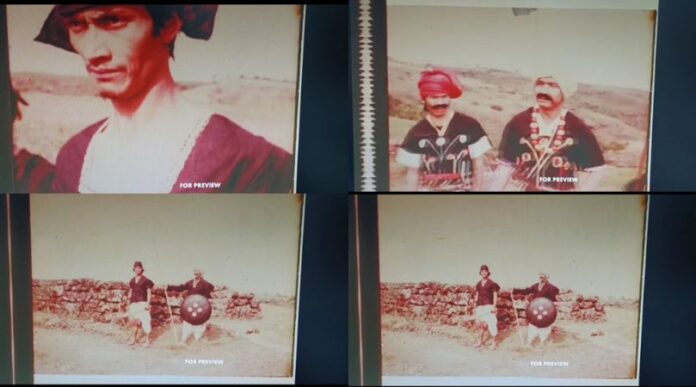Cherry K. Kharshiing
When one Googles Anglo- Khasi war, Wikipedia will give us the historical account of the war fought between Tirot Sing and the British’s East India Company in 1826 which lasted till 1833. This is a well-known struggle. Without the intention of diminishing Tirot Sing’s attempts, sacrifices and contribution towards the cause of the Khasi freedom struggle at that time, the war fought by him came in the last phase of the freedom struggle. There was other Anglo- Khasi resistance spread across different parts of the Khasi Hills before Tirot Sing came to the scene.
In the year 1981, Bah Hamlet Bareh Ngapkynta made a humble but noteworthy attempt to document these pre-1826 Anglo-Khasi resistance in his film Synjuk Ri Ki Laiphew Syiem- (1780-1810). Whether Bah Hamlet Bareh realised it or not, the release of this film way back in 1981 became groundbreaking. It became the first Khasi feature film. History was made just like that.
Well, not exactly “just like that”. It had a cast of more than fifty amateur actors, a crew of 20-odd amateur talents who handled the camera, the lighting, the make-up, the costume and the sets.
To understand a film like Synjuk Ri Ki Laiphew Syiem with synjuk being a Khasi word for alliance, we must first ask the question, can we separate the content from the craft of creating that content? Usually my answer would be a resounding ‘no’ but I am willing to make an exception in this case because of the towering stature of this film for the Khasis.
The director of this film was also a historian by profession and it came as no surprise that the content of his first and only film is a subject matter of the history of the Khasis. In his book, The language and Literature of Meghalaya, (1977), he wrote,
“Tirot Singh is well known to have fought a war from 1826 till 1833 but this war came at the last phase of a Khasi freedom struggle. For a tradition says that the southern Khasis started to fight with the British Government much earlier, dating back to 1765 after the East India Company acquired Sylhet from the Mughal emperor as a dewani. They had been in the field sixty years before U Tirot Singh”. (Page 104)
Bah Hamlet Bareh was so convinced of this truth that he went on to make a film on this subject matter. Accordingly, the East India Company had either intentionally or unintentionally encroached upon the territories which belonged to Hima Shella, Maram, Sohra, Sohbar, Mawiang, Bhowal, Jaintia and other Khasi Himas. In the film we see this encroachment in a small outdoor scene where U syiem had a small interaction with his son. He was pointing towards the distant fold of hills and lamented that there was a time when those faraway lands were part of Ri Khasi.
The film then moves on to the period when the East India Company had set up shop in our hills and the relationship between the Khasi syiems and the Britishers became sour because of the latter’s constant political and social interference. This strained relation caused damage to the Khasi trade and administration as well. Fed up with the Company’s attempts to control trade, impose tax and annex the hills’ territories, some of these syiems decided to take matters in their own hands and give the Britishers a run for their money.
While assessing the narrative of the film one realises that in the first part of the film, which was shot in black and white, we can see scenes of these raids and how the Khasis caused havoc on the Britishers by destroying their outposts and massacring the British officers. We also saw triumphant warriors returning home with the booties they acquired from these raids.
The second part of the film which is now shot in colour – we can’t be sure whether it is intentional or technical- takes us to an alliance of the thirty syiems. This alliance was led by U Ksan, who was the then wahadadar or leader of Hima Shella, U Buh Singh the II, the Syiem of Hima Sohra, Ka Syiem Wan of Hima Maram, U Syiem Phan of Hima Nongstoin. It is interesting to note that Syiem Wan being the only woman in the alliance was also the only one whose costume was taken care of. She was dressed in fineries and she even wore a crown. It was in this alliance that important decisions were taken like refusing to continue to pay taxes to the Britishers and to help each other in trading the goods produced locally by the people. The film and the alliance ended up with the Khasi dance to celebrate this coming together and to symbolically call for the cry that ‘united we stand and divided we fall’.
Bah Hamelet Bareh rewrote a part of the Khasi history through the medium of films. This rewriting is not visually legible. The film grammar of Synjuk Ka Ri Laiphew Syiem is all over the place. It displayed no cinematic grandeur of today’s context. It had no flamboyant and flexible acting. It had no fantastic settings. It did not boast of make-up and costume that takes our breath away. On the other hand, it had a jumbled up narrative, lazy and casual cinematography, uninteresting dialogues, and no editing plan. Yet we must not be embarrassed by it. It must be appreciated for its authenticity and not its technicality. We must celebrate it for its raw attempt to capture something which no one had dared to do before it. It is part of the Khasi legacy and we must be brave enough to take ownership of it.
(The film will be screened at 2 pm on March 18 in U Soso Tham auditorium as part of the 1st Meghalaya International Film Festival organised by the Meghalaya Filmmakers’ Association from March 14.)


